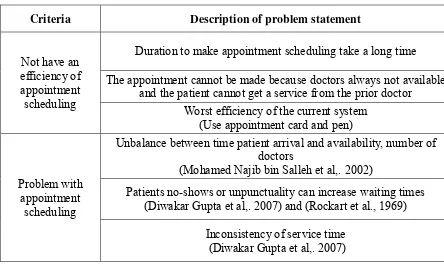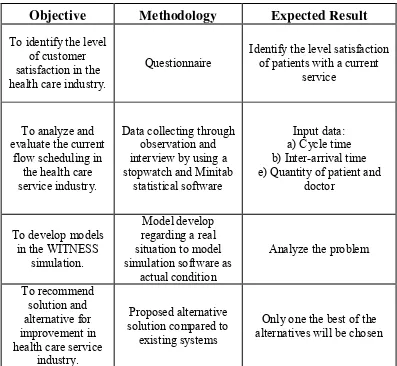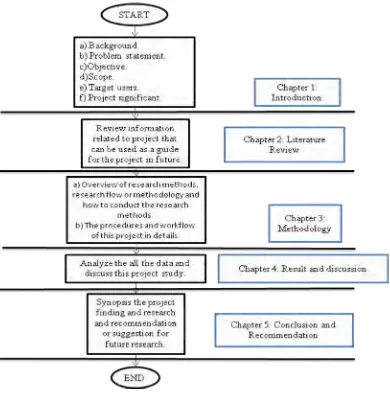UNIVERSITI TEKNIKAL MALAYSIA MELAKA
This report submitted in accordance with requirement of the Universiti Teknikal Malaysia Melaka (UTeM) for the Bachelor Degree of Manufacturing Engineering
(Manufacturing Management Hons.)
by
NORHAZWANI BINTI BAHARUDIN B051210168
910304-02-6190
FACULTY OF MANUFACTURING ENGINEERING 2015
APPOINTMENT SCHEDULING IN HEALTH CARE INDUSTRY
I hereby, declared this report entitled “Appointment Scheduling in Health Care Industry by Using Modelling and Simulation” is the results of my own research except as cited in the references.
Signature : ………
Author’s Name : Norhazwani Binti Baharudin
Date : ………
This report is submitted to the Faculty of Manufacturing Engineering of UTeM as a partial fulfilment of the requirements for the Bachelor of Manufacturing Engineering (Manufacturing Management) (Hons.) The member of the supervisory is as follows:
………
Dalam projek ini, jadual temujanji ialah sistem yang berfungsi untuk mengaturkan jadual temujanji antara pelanggan dan doktor. Salah satu poliklinik komuniti di Melaka dipilih sebagai satu kajian yang bertumpukan pada jabatan kesihatan ibu dan anak. Tujuan kajian ini adalah untuk meningkatkan kecekapan jadual temu janji melalui kaedah permodelan dan simulasi. Soal selidik dilakukan untuk mengetahui suara pelanggan tentang senario jadual temujanji pada masa kini. Dari tinjauan ini, kebanyakan pelanggan yang melawat poliklinik ini adalah jenis ibu mengandung dan kesihatan bayi. Tambahan pula, kebanyakan pelanggan melawat poliklinik ini adalah dalam sesi pagi dan lebih daripada 60% pelanggan perlu meluangkan masa lebih daripada satu jam di dalam sistem. Parameter yang digunakan adalah tempoh masa perkhidmatan, antara waktu mendaftar masuk dan bilangan pelanggan dan doktor. Kesemua data yang dikumpul adalah taburan normal. Kemudian, data dimodelkan kedalam simulasi WITNESS dan masalah utama yang dapat dikenalpasti adalah kesesakan berlaku di Bilik 21 (Doktor) dan makmal. Beberapa alternatif telah dicadangkan dan diaplikasikan dalam model simulasi untuk mengkaji tingkah laku dan pretasi sistem. Dengan mengubah aliran proses, peningkatan bilangan pelanggan kepada 19.17% dengan mengekalkan seorang doktor dengan tiada implikasi kos. Lebih mengejutkan, dengan mempunyai dua orang doktor dalam sistem, jumlah pelanggan hanya meningkat kepada 6.41%. Maka, aliran proses yang baru dengan seorang doktor telah dipilih sebagai penyelesaian terbaik dalam kajian ini.
In this project, appointment scheduling is system that functionally to arrange the scheduling appointment between customer and doctors. One of the polyclinic community in Melaka been selected as a case study which emphasis in maternal and children health department. The aim of this study to increase the efficiency of appointment scheduling through modelling and simulation methodology. The questionnaire developed to capture the voice of customer about the current appointment scheduling scenario. From this survey, the most type of customer visit maternal and child health department are antenatal and neonatal. Furthermore, mostly customers visit this polyclinics are in morning session and more than 60% of the customer need to spend more than a hour in the system. The parameters that use are duration service time, inter-arrival time and quantity of customer and doctor. All the data collected are normal distribution. Then, data are translated into WITNESS simulation and the main problem identified is the bottlenecks occur at Room 21 (Doctor) and laboratory. Several alternatives recommended in this simulation model are conducted to study the behaviour and performance of the system. By changing the process flow, the number of customer increase to 19.17% by maintaining one doctor with no cost implication. Surprisely, with having two doctors in the system, the number of customer only increase to 6.41%. Hence, the new process flows with one doctor are chosen as best solution in this case studies.
Dedicated to my beloved mother and father, Hjh. Norzihan Binti Abdul Kader and Hj. Baharudin Bin Wahab for always give support to me for finishing this project. Other, Dedicated to those who had never give up support and encourage me, especially my supervisor and friends.
I would like to extend my sincere thanks to my supervisor, Nor Akramin Bin Mohamad for his invaluable guidance and assistance throughout this project. I appreciate the knowledge and advise that was gained from my supervisor. He had given me valuable cooperation, assistance, support and suggestion during my projects activities. In particular, I wish to express my special thanks to Dr. Rusdi Bin Abd Rahman, Deputy Director of State Health (Public Health), for giving me a permission to make these case studies at Polyclinic Community. Besides, I would like to express my special thanks to Dr. Suhaimi Bin Mohd Isa and Sr. Noor Hafizan Johar for spend their precious time to guide me. Furthermore, I deeply appreciate the cooperation of doctor, staff and patients at Polyclinic Community that providing the opportunity to perform my research study and giving full support when I was carried out the questionnaire and collecting a data. Special thanks to my fellow friends for giving me a full support and always share an idea and knowledge to developing this case study. Last but not least, I would like to thank to my lovely parents always give me a support and motivated to me to lead this project from beginning until end.
Abstrak i
List of abbreviations, symbols, specialized nomenclature xiii CHAPTER 1: INTRODUCTION 1
1.1 Background 1
1.2 Problem statement 2
1.3 Objectives 3
1.4 Scope 4
1.5 Target users 4
1.6 Project significance 4
1.7 Expected output 5
1.8 Report summary
1.8.1 Introduction 1.8.2 Literature review 1.8.3 Methodology
1.8.4 Result and discussion
1.8.5 Conclusion and recommendation
6
CHAPTER 2: LITERATURE REVIEW 9
2.1 Appointment scheduling
2.1.1 Why appointment scheduling important
2.1.2 Scheduling disciplines 10 2.2 Health care industry
2.2.1 Polyclinic community
2.2.2 Maternal and children health department
11 11 12 2.3 Modelling and simulation
2.3.1 Purpose of modelling and simulation 2.3.2 When modelling and simulation be used 2.3.3 Develop simulation models
2.3.4 Types of simulation models
2.3.4.1 Discrete-event simulation modelling 2.3.4.2 Continuous simulation modelling 2.3.5 Advantages and disadvantages of simulation
2.3.5.1 Advantages 2.4 Software simulation
2.4.1 WITNESS simulation software
19 19 2.5 Problem definition
2.5.1 No-shows 2.5.2 Punctuality
2.5.3 Duration of consulting
19 19 20 20
2.5 The review about appointment scheduling 21
2.6 Method solve appointment scheduling 23
2.7 Summary 24
2.8 Parameter 25
CHAPTER 3: METHODOLOGY 26
3.1 Process flow conducting project 3.1.1 Information research 3.1.2 Conceptualization 3.1.3 Methodology design 3.1.4 Implementation of project 3.1.5 Documentation
3.2.1 Questionnaire
3.2.1.1 Main modes questionnaire administration 3.2.1.2 Analysis of questionnaire
3.2.2 Model translation
CHAPTER 4: RESULT AND DISCUSSION 34
4.1 Questionnaire result analysis
4.1.1 Category services: Question 1 4.1.2 Zone area: Question 2
4.1.3 Level satisfaction of customer: Question 3 4.1.4 Availability time for an appointment: Question 4 4.1.5 Current duration waiting time: Question 5
4.1.6 Maximum time willing to spend for the whole services: Question 6
4.1.7 Current whole service time: Question 7 4.1.8 Reason chooses this polyclinic: Question 8 4.1.9 Main problem in this polyclinic: Question 9 4.1.10 Suggestion improve services: Question 10
34 4.2 Process flow available in maternal and children department 45
4.3 Process flow for antenatal and neonatal 46
4.4 Data collection 47
4.5 Model translation 4.5.1 Input data
4.5.1.1 Cycle time 4.5.1.2 Command 4.5.1.3 Output
4.5.2 Command for each service area
48 4.6 Verification and validation
4.6.1 Verification
4.6.2 Validation
4.6.2.1 Distribution of data 4.6.2.2 Validation of result
58 58 60 4.7 Alternative for improvement
4.7.1 Alternatives 4.7.2 Command change
61 61 62 4.8 Result on simulation
4.8.1 Graph of output 4.8.2 Alternative chosen
66 79 80
CHAPTER 5: CONCLUSION AND RECOMMENDATION 81
5.1 Conclusion of research 81
5.2 Recommendation 82
1.1 Problem statement identify in an appointment scheduling 3
1.2 Expected output of case study 5
2.1 The review of an appointment scheduling 21
2.2 Method and parameter used to solve appointment scheduling 23
2.3 The summary of other research 24
2.4 The parameter used in collecting data 25
4.1 Mean of cycle time for each service area 47
4.2 Mean of number of customer 47
4.3 Command from each service area and part 56
4.4 Differences number of customers between current simulations and real scenario
60
4.5 Description of each alternative 62
4.6 Comparing alternative that chosen 80
4.7 Summary of findings in this research 81
1.1 Flow chart of report summary 6
2.1 Polyclinic community 12
2.2 Statistics of people in Malaysia 13
2.3 Maternal and child health department 13
2.4 Process flow to develop simulation models 16
3.1 Process flow chart for conducting project 27
3.2 Method use to achieve an objective 30
4.1 Graph of number respondent and percentages (Category services) 35 4.2 Graph of number respondent and percentages (Zone area) 36 4.3 Graph of number respondent and percentages (Level satisfaction of
customer)
37
4.4 Graph of number respondent and percentages (Availability time for an appointment)
38
4.5 Graph of number respondent and percentages (Current duration waiting time)
39
4.6 Graph of number respondent and percentages (Maximum time willing to spend for the whole srvices)
40
4.7 Graph of number respondent and percentages (Current whole service time)
4.10 Graph of number respondent and percentages (Suggestion improve services)
44
4.11 Process flow for antenatal and neonatal 46
4.12 WITNESS simulation model layout with one doctor 48 4.13 WITNESS simulation model layout with two doctors 49
4.14 Model simulation during running 50
4.15 An example input cycle time data 51
4.16 The command at Room 15 when the change process flow 52 4.17 The command in counter book when the change process flow 53
4.18 The action of start at pharmacy 54
4.19 The action to finish at the pharmacy 55
4.20 The actions on output 55
4.21 Data distribution 59
4.22 Probability plot for Room 17 59
4.23 Changing process flow 66
4.24 The output WITNESS simulation model layout with one doctor with opening Room 19
67
4.25 The output WITNESS simulation model layout with one doctor with change process flow
69
4.26 The output WITNESS simulation model layout with one doctor with reduce cycle time
70
4.28 The output WITNESS simulation model layout with one doctor without opening Room 19
71
4.29 The output WITNESS simulation model layout with one doctor with the combined change flow and reduce cycle time
72
4.30 The output WITNESS simulation model layout with one doctor without opening Room 19 and combine change process flow and reduce cycle time
73
4.31 The output WITNESS simulation model layout with two doctors and change process flow
74
4.32 The output WITNESS simulation model layout with two doctors and reduce cycle time
75
4.33 The output WITNESS simulation model layout with two doctors without opening Room 19
76
4.34 The output WITNESS simulation model layout with two doctors with
time
4.35 The output WITNESS simulation model layout with two doctors without opening Room 19 and combine change process flow and reduce cycle time
78
FCFS - First Come First Serve FIFO - First In First Out
SJF - Shortest Remaining Time or Shortest Job First FPPS - Fixed Priority Pre-emptive Scheduling
RR - Round-Robin Scheduling
Sec - Seconds
Num - Number
This chapter will give an overview of the whole project, where it is essentially in five chapters. The project background will be introduced in section one. Next, problem statement will be stated in section two. Section three, four and five will be covered with objective of project, scope and target users respectively. Lastly, the second last and last section will discuss about the project significant and expected output respectively.
1.1 BACKGROUND
Health care industry, increasing rapidly due to increasing demand from the customer and while the rapid augmentation of technology, but as everyone knows, lacks of an appointment scheduling still cannot be solved. Appointment scheduling needs to be minimized due it comprises the patients’ health. Lacks appointment scheduling is a cause of unbalance time between patient arrival and number of availability of doctor, patient no-shows, unpunctuality of patient and inconsistency service time. Nowadays, simulation is broadly used to present the real system in the health care industry in recognizing the exact problem, improve an efficiency appointment scheduling and finding the best alternatives to resolve a problem. Modeling and simulation are used to give a whole picture of the system. In the simulation, a model will construct through a programming on the computer where it will show close approximately the plan view of polyclinic with an animation of part moving through the system.
1.2 PROBLEM STATEMENT
Lacks of system in appointment still occur, although the technologies are increasing. From the current system, the duration to make an appointment take a long time especially at the registration counter. This situation is wasting time and sometime after waiting for a long time, an appointment cannot be made. These situations occur cause of the very worst efficiency at current system due the customer only can get a service after making an appointment. In case if the doctor was not available or doesn’t have any time slots, the patient just wasted their time because cannot get any consultant.
Other than that, appointment also always full and the customer cannot make any appointment until the time is available. The current situation, the customer cannot get a service from the same doctor and this problem can give a bad impact to the customer because only doctor that have treated before knows the real disease of the customer. All this situation is occurring by lack effectively appointment scheduling from the current system cause of the use of paper and pen to make an appointment. By using a pen and an appointment card, the updates will be much slower when new appointments are being added. Moreover, the probability of losing the appointment card is higher.
Table 1.1: Problem statement identify in an appointment scheduling
Criteria Description of problem statement
Not have an efficiency of appointment scheduling
Duration to make appointment scheduling take a long time The appointment cannot be made because doctors always not available
and the patient cannot get a service from the prior doctor Worst efficiency of the current system
(Use appointment card and pen)
Problem with appointment
scheduling
Unbalance between time patient arrival and availability, number of doctors
(Mohamed Najib bin Salleh et al,. 2002)
Patients no-shows or unpunctuality can increase waiting times (Diwakar Gupta et al,. 2007) and (Rockart et al., 1969)
Inconsistency of service time (Diwakar Gupta et al,. 2007)
1.3 OBJECTIVES
a) To identify the level of customer satisfaction in these health care industries.
b) To analyze and evaluate the current flow scheduling in the health care service industry.
c) To develop models in the WITNESS simulation software.
1.4 SCOPE
The case study mainly focuses on the appointment scheduling in the health care industry at one of the Polyclinic Community in Melaka which emphasis on maternal and child health department. Only two types of customer; neonatal and antenatal, considered in this case study. The model of the real system will develop using the WITNESS simulation software.
1.5 TARGET USERS
a) Doctor/Nurses
b) Customer (Antenatal and neonatal)
1.6 PROJECT SIGNIFICANCE
By using modeling and simulation to solve appointment scheduling in health care industry will give benefits to manage an appointment with more organized and efficiency between patient and doctor. It is also can control the scheduling and eliminate any waste time. By having an efficiency of an appointment scheduling also can reduce the time and cost. Other than that, patients will more satisfy with the service and a doctor also can give their best service.
1.7 EXPECTED OUTPUT
Table 1.2 shows the expected output from this case study. The expected output is very important to know and give a picture what to achieve from each objective that has been stated earlier in this project.
Table 1.2: Expected output of case study
Objective
Methodology
Expected Result
To identify the level of customer satisfaction in the health care industry.
Questionnaire Identify the level satisfaction of patients with a current service interview by using a stopwatch and Minitab
statistical software
Input data: a) Cycle time b) Inter-arrival time e) Quantity of patient and
doctor
Analyze the problem
1.8 REPORT SUMMARY
Figure 1.1 shows the summary of this report. This study is divided into five main parts which is chapter 1 (Introduction), chapter 2 (Literature review), chapter 3 (Methodology), chapter 4 (Result and discussion) and lastly chapter 5 (conclusion and recommendation).
1.8.1 Introduction
The introduction has been made through the analysis and review of the previous case study from the literature review. In this chapter is the second step to identify the whole review of this case study. The background of the project, the problem statement, objective, scope, target users and project significant are chosen before going to the next step. All of this being made after discussion with the supervisor to conduct the project.
1.8.2 Literature review
Literature review are the first step to conduct this report. The relevant and necessary information which regarding to the title of the project such as the title of the project, the parameter used, the finding from the previous case study and an example of a previous case study that relate to the project. These case studies have been done through a sources such as reference book, journal and article.
1.8.3 Methodology
In order to ensure the project are conduct smoothly, methodology of case study has been developed as shown in Figure 3.1 and Figure 3.2 after introduction and literature review be made. From these figures, there is four phase and every phase are shown the methods and tools used for each objective
1.8.4 Result and discussion
1.8.5 Conclusion and recommendation


